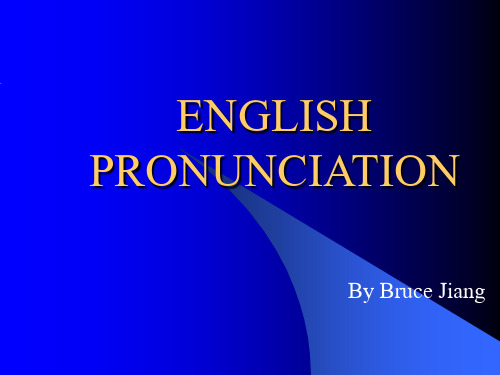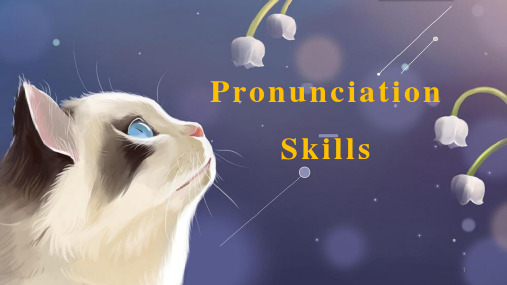英语发音技巧系列课件 3.Prounciation Skills- 音的同化、异化、弱化
合集下载
Pronunciation Skills.ppt

舌侧音:/l/
1)爆破音+爆破音, 如 a flat tire, blackboard, Red Cross 中的斜体部分一律失去爆破。这叫完全失去爆破。
2)爆破音+摩擦音或破擦音,如 a sad story, a nonstop flight, recite the poem, a good chance, odd jobs等中的斜体部分只有轻微的爆破。这叫做不完 全失去爆破。
Pronunciation Skills
Linking Stress Intonation Thought Group
Words are linked in two main situations:
1
Consonant / vot / vowel
Note: 逻辑重音—句子的重音总是要表现说话人的思想和他所 要表达的意思的重点。有时为了强调,句子中几乎任何 词都可以有句子重音,包括一些通常没有句子重音的词, 这种依说话人意图重读的音就是逻辑重音。
Are you ’angry with me? (Normal) Are you ’angry with ’me? Are ’you ’angry with me?
Early to bed / and early to rise / makes a man/ healthy, happy and wise.
Jane, who’s a brilliant swimmer, represented Britain at the Olympic Games.
Jane, / who’s a brilliant swimmer, / represented Britain / at the Olympic Games.
失去爆破
1)爆破音+爆破音, 如 a flat tire, blackboard, Red Cross 中的斜体部分一律失去爆破。这叫完全失去爆破。
2)爆破音+摩擦音或破擦音,如 a sad story, a nonstop flight, recite the poem, a good chance, odd jobs等中的斜体部分只有轻微的爆破。这叫做不完 全失去爆破。
Pronunciation Skills
Linking Stress Intonation Thought Group
Words are linked in two main situations:
1
Consonant / vot / vowel
Note: 逻辑重音—句子的重音总是要表现说话人的思想和他所 要表达的意思的重点。有时为了强调,句子中几乎任何 词都可以有句子重音,包括一些通常没有句子重音的词, 这种依说话人意图重读的音就是逻辑重音。
Are you ’angry with me? (Normal) Are you ’angry with ’me? Are ’you ’angry with me?
Early to bed / and early to rise / makes a man/ healthy, happy and wise.
Jane, who’s a brilliant swimmer, represented Britain at the Olympic Games.
Jane, / who’s a brilliant swimmer, / represented Britain / at the Olympic Games.
失去爆破
ENGLISH PRONUNCIATION 英语发音学习PPT课件

Attention should be paid to the most intriguing sound. (why?)
Examples: ill sit miss city
lady silly silk kid
[I] v.s.[i:]
Ship--sheep slip—sleep this—these lip—leap
Some Troublemakers For Chinese
5. [e]
Examples: egg desk many pen dead head
end lend tend
Sentence Drill
The eggs he sells are better than everybody else sells.
ENGLISH PRONUNCIATION
By Bruce Jiang
Wrong Ideas About Pronunciation
Pronunciation is the least important skill in the second language acquisition.
Pronunciation must be good if only one mimics as much as possible.
Some Troublemakers For Chinese
4. [u]
Example: look push good foot cook
woman wood bush hook should
Rule:When “oo” occurs before [k] and [d], “oo” will be read as [u] except “food” and “foot”.
Examples: ill sit miss city
lady silly silk kid
[I] v.s.[i:]
Ship--sheep slip—sleep this—these lip—leap
Some Troublemakers For Chinese
5. [e]
Examples: egg desk many pen dead head
end lend tend
Sentence Drill
The eggs he sells are better than everybody else sells.
ENGLISH PRONUNCIATION
By Bruce Jiang
Wrong Ideas About Pronunciation
Pronunciation is the least important skill in the second language acquisition.
Pronunciation must be good if only one mimics as much as possible.
Some Troublemakers For Chinese
4. [u]
Example: look push good foot cook
woman wood bush hook should
Rule:When “oo” occurs before [k] and [d], “oo” will be read as [u] except “food” and “foot”.
2.Pronunciation

4)、爆破音 + 破擦音 [ts] [tʃ] [tr] [dz] [dʒ] [dr]——爆破音不完全爆破, 即形成阻碍, 稍作停顿, 不送气 : great changes / good jobs / that child / grandchild / picture / object
5)、爆破音 + 摩擦音 [f] [v] [s] [z] [θ] [ð] [ʃ] [ʒ] [h ] [r ]——爆破音不完全爆破,即 形成阻碍,稍作停顿,不送气 :
1.失去爆破
爆破音[b] [p] [d] [t] [g] [k]
1)爆破音 + 爆破音(即爆破音[b] [p] [d] [t] [g] [k] 相邻时)——前一个发不完全的爆 破音,即只象原样形成阻碍,稍作停顿, 不送气
She took good care of the children. Ask Bob to sit behind me. big boy sharp pencil what time September suitcase blackboard handbag goodbye
/tm/ excitement a bit more eight men /dm/ admit a good many
atmosphere white mice sad music broad minded
3)、[t] [d] + 舌边音[l]——[t] [d]在词尾需由 舌两侧爆破(如 little),在词中或短语中 则形成不完全爆破: at last / good luck / straight line / I’d like to. / a bit louder / friendly / mostly
英语发音技巧系列课件 2.Prounciation Skills- 连读、省音、吞音

17
2.2 “点到为止”
• 爆破音和辅音辅音相遇时,前面的爆破音发音顿息,舌头到达发音部位“点到 为止”,但不送气。 在正常速度或快速的对话中,字尾有 /t/ /d/ 时通常不会把 /t/ /d/ 发音清楚地念出来,而是快要念出来的时候马上憋气顿息,因此字尾的 /t/ /d/ 常常听不到。
• 如果前一个词结尾的音是 [i:] [ei] [ai][ɔi],在与后面元音连续读的时候可加 [j] 音。 ➢ stay awake ➢ tie it up
• 如果前一个词结尾的音是 [u] [au] [əu] 在与后面元音连续读的时候可加 [w] 音。 ➢ How interesting! ➢ Let's go on
• I'm an English boy. • It is an old book. • Let me have a look at it. • Ms Black worked in an office last year. • I called you half an hour ago. • Put it on, please. • Not at all. • Please pick it up.
11
1.5.1 [u] + Vowel
• do it • do it on purpose
• He said he didn't do it on purpose. • I blew it. • He is our new accoutant. • I had lunch about two hours ago.
13
1.5.3 [au] + Vowel
• allow it • They won't allow it.
2.2 “点到为止”
• 爆破音和辅音辅音相遇时,前面的爆破音发音顿息,舌头到达发音部位“点到 为止”,但不送气。 在正常速度或快速的对话中,字尾有 /t/ /d/ 时通常不会把 /t/ /d/ 发音清楚地念出来,而是快要念出来的时候马上憋气顿息,因此字尾的 /t/ /d/ 常常听不到。
• 如果前一个词结尾的音是 [i:] [ei] [ai][ɔi],在与后面元音连续读的时候可加 [j] 音。 ➢ stay awake ➢ tie it up
• 如果前一个词结尾的音是 [u] [au] [əu] 在与后面元音连续读的时候可加 [w] 音。 ➢ How interesting! ➢ Let's go on
• I'm an English boy. • It is an old book. • Let me have a look at it. • Ms Black worked in an office last year. • I called you half an hour ago. • Put it on, please. • Not at all. • Please pick it up.
11
1.5.1 [u] + Vowel
• do it • do it on purpose
• He said he didn't do it on purpose. • I blew it. • He is our new accoutant. • I had lunch about two hours ago.
13
1.5.3 [au] + Vowel
• allow it • They won't allow it.
Pronunciation纠正英语发音PPT幻灯片

2
Pronunciation
Stressed words in sentences: Nouns and main verbs Descriptive words (adjectives and
adverbs) The first word of open compounds Preposition of phrasal verbs
(What is Continuous Consonants? Click)
Linking Discontinuous Consonants/Stops and Affricates
(What is Discontinuous Consonants? Click)
Linking vowels
1
Pronunciation
Sentence stress simply means saying the most important words of a sentence a little bit louder, or for a little bit longer than the others. The speaker alternates between stressed and unstressed syllables in regular intervals, with the stresses falling within content words. This is called the Rhythm Rule. The stressed syllables of the sentence create beats.
Clare
That’s an easy one. Melinda
Gates, she’s my hero.
Pronunciation
Stressed words in sentences: Nouns and main verbs Descriptive words (adjectives and
adverbs) The first word of open compounds Preposition of phrasal verbs
(What is Continuous Consonants? Click)
Linking Discontinuous Consonants/Stops and Affricates
(What is Discontinuous Consonants? Click)
Linking vowels
1
Pronunciation
Sentence stress simply means saying the most important words of a sentence a little bit louder, or for a little bit longer than the others. The speaker alternates between stressed and unstressed syllables in regular intervals, with the stresses falling within content words. This is called the Rhythm Rule. The stressed syllables of the sentence create beats.
Clare
That’s an easy one. Melinda
Gates, she’s my hero.
学习版英语语音技巧.ppt

;.;
二、 连读 连读有两种规则,分别为: + 1、 以辅音结尾的单词+元音开头的单词:
要连读 如:No(t a)(t a)ll.
I’d li(ke a)nother bow(l o)f rice. 这里like / laik / 以辅音结尾,another 以元 音开头,所以连读 注意:
+ 以辅音结尾 指的是音标中的最后.;
+ 2、以辅音结尾的单词 + h开头的单词,h不 发音,与前面的辅音连读。
+ Ha(s he) [zi] done it before? + Lea(ve him) [vim]. + For him [rim].
;.;
三、 音的同化 音的同化也是一种连读的现象,两个词
六,音调
Will you accept my gift? ↑ You like it? ↑ It doesn’t matter. ↓ How can I make it up to you? ↓ I was going to write, ↑ but I lost your address . ↓ You will say sorry to him, ↓ won’t you? ↑ Do you like to lose face ↑ or lose a friend? ↓
之间非常平滑的过渡,导致一个音受邻音 影响而变化。主要是以下三种方式: 1、 辅音[d]与[j]相邻时,被同化为[dэ]: Would you...? 2、 辅音[t]与[j]相邻时,被同化为[t∫]: Can’t you…? 3、 辅音[s]与[j]相邻时, 被同化为[∫]: Miss you…
;.;
注意: 升调一般表示不确定或未完成,降调表示肯定和完成。
二、 连读 连读有两种规则,分别为: + 1、 以辅音结尾的单词+元音开头的单词:
要连读 如:No(t a)(t a)ll.
I’d li(ke a)nother bow(l o)f rice. 这里like / laik / 以辅音结尾,another 以元 音开头,所以连读 注意:
+ 以辅音结尾 指的是音标中的最后.;
+ 2、以辅音结尾的单词 + h开头的单词,h不 发音,与前面的辅音连读。
+ Ha(s he) [zi] done it before? + Lea(ve him) [vim]. + For him [rim].
;.;
三、 音的同化 音的同化也是一种连读的现象,两个词
六,音调
Will you accept my gift? ↑ You like it? ↑ It doesn’t matter. ↓ How can I make it up to you? ↓ I was going to write, ↑ but I lost your address . ↓ You will say sorry to him, ↓ won’t you? ↑ Do you like to lose face ↑ or lose a friend? ↓
之间非常平滑的过渡,导致一个音受邻音 影响而变化。主要是以下三种方式: 1、 辅音[d]与[j]相邻时,被同化为[dэ]: Would you...? 2、 辅音[t]与[j]相邻时,被同化为[t∫]: Can’t you…? 3、 辅音[s]与[j]相邻时, 被同化为[∫]: Miss you…
;.;
注意: 升调一般表示不确定或未完成,降调表示肯定和完成。
高考英语听力指导 英语口语中的同化、连读、弱读和不完全爆破技巧(共18张PPT)

(三) 爆破音+破擦音 /ts/、/dz/,/tr/、/dr/、/ tʃ/、 /dʒ /
1. I’m going give you one last chance. 我在给你最后一次机会。 2. Good-bye to this dead-end job! 别了,这份没前途的工作!
picture lecture
英语弱读
弱读的一半规则:元音一次弱化之后主要是变为/ə/, 二次弱化后这个音就消失了;辅音弱化后也消失了。 下面介绍常用单词的弱读形式
单词 弱读音标
疯狂操练
and /n/
You n’ me are pretty good friends.
can /kən/ I can drive a car.
are /r/
英语口语中的同化、连读、弱读和不完全爆破
同化
• 同化是两个音相互作用,导致最后产生另外一个音 的现象,这样可以使句子显得更流畅。 1. /s/+/j/→/ʃ/ 如:this year等 (1) I guess you’re right. 我想你是对的。 (2) I miss you. 我想念你。 2. /z/+/j/→/ʒ/ (1) What brings you here? 什么风把你刮到这儿来了? (2) I’m not gonna lose you again.
(1)Pinned ya. 压在你身上了。(《狮子王》中的 一句台词,听起来是/ˈpinʤə/。这两个单词包含的 发音规则有弱读+同化。)
(2)How did you like it? 你觉得怎样?
英语中的连读 在正常英语口语中,连读现象比比皆是。有些 较短的句子听起来简直就像一个单词,所以学好连 读是通向流利英语必经之路。 1.词尾辅音+词首元音 这种连读最常见也最简单,把相邻的两个单词想象 成一个单词即可。 (1) I’m so fed up with him. 他让我烦透了。 (2) I’ve already made up my mind. 我意已决。 (3) That is so gross [ɡrəus].太俗了。 (4) Turn on the juice. 合上开关,恢复通电。 (juice也有电的意思)
初中英语人教新目标七年级上册Pronunciation音标教学PPT

5-10号元音的发音特点是:声带振动
Jul 9th, 2010
8:00-9:30am or 4:00-5:30pm
25
Part 2 – 学习另3对辅音音标
4. /f/ f 清辅音 farm /fɑ:m/ five /faɪv/ fire /faɪə/ knife /naɪf/ ph 清辅音 phone /fəʊn/ photo /fəʊtəʊ/
9. /ʊ/ u look /lʊk/ put /pʊt/ pull /pʊl/ sugar /ʃʊgə/ oo book /bʊk/ cook /kʊk/ good /gʊd/ look /lʊk/
10. /u:/ oo cool /ku:l/ food/fu:d/school /sku:l/ zoo /zu:/ ou soup /su:p/ group /gru:p/ through /θru:/ ui juice /dʒu:s/ fruit /fru:t/ u blue/blu:/ glue/glu:/
2) 含元音音素[i:] 字母: Bb Cc Dd Ee Gg Pp Tt Vv 音标: [bi:] [si:] [di:] [i:] [d3i:] [pi:] [ti:] [vi:]
3) 含元音音素[e] 字母: Ff Ll Mm Nn Ss Xx Zz 音标: [ef] [el] [em] [en] [es] [eks] [zed]
2. /ɪ/ i big /bɪg/ it /ɪt/ kid /kɪd/ pig /pig/
以 y/ey结尾 twenty/twenti/ monkey/mʌŋki/ money/mʌni/
3. /e/ e hen /hen/ egg /eg/ red/red/ pen/pen/ ea head /hed/ ready /redi/ bread/bred/
Jul 9th, 2010
8:00-9:30am or 4:00-5:30pm
25
Part 2 – 学习另3对辅音音标
4. /f/ f 清辅音 farm /fɑ:m/ five /faɪv/ fire /faɪə/ knife /naɪf/ ph 清辅音 phone /fəʊn/ photo /fəʊtəʊ/
9. /ʊ/ u look /lʊk/ put /pʊt/ pull /pʊl/ sugar /ʃʊgə/ oo book /bʊk/ cook /kʊk/ good /gʊd/ look /lʊk/
10. /u:/ oo cool /ku:l/ food/fu:d/school /sku:l/ zoo /zu:/ ou soup /su:p/ group /gru:p/ through /θru:/ ui juice /dʒu:s/ fruit /fru:t/ u blue/blu:/ glue/glu:/
2) 含元音音素[i:] 字母: Bb Cc Dd Ee Gg Pp Tt Vv 音标: [bi:] [si:] [di:] [i:] [d3i:] [pi:] [ti:] [vi:]
3) 含元音音素[e] 字母: Ff Ll Mm Nn Ss Xx Zz 音标: [ef] [el] [em] [en] [es] [eks] [zed]
2. /ɪ/ i big /bɪg/ it /ɪt/ kid /kɪd/ pig /pig/
以 y/ey结尾 twenty/twenti/ monkey/mʌŋki/ money/mʌni/
3. /e/ e hen /hen/ egg /eg/ red/red/ pen/pen/ ea head /hed/ ready /redi/ bread/bred/
- 1、下载文档前请自行甄别文档内容的完整性,平台不提供额外的编辑、内容补充、找答案等附加服务。
- 2、"仅部分预览"的文档,不可在线预览部分如存在完整性等问题,可反馈申请退款(可完整预览的文档不适用该条件!)。
- 3、如文档侵犯您的权益,请联系客服反馈,我们会尽快为您处理(人工客服工作时间:9:00-18:30)。
8
1.4 相互同化
• 相互同化就是前后两个连在一起得音念起来不太方便, 于是连在一起的两个音就互为影响而混合成一个新的、 折衷的、比较好念的音,使之念起来顺口、听起来顺耳、 看起来顺眼。此类同化并非是随意的,而是有规可循的。
9
1.4.1 [d]+[j]=[dʒ]
• Could you …? • Would you …? • Did you…? • And you? • I need you to… • I need your help. • Let the light guide your way.
10
1.4.2 [t]+[j]=[tʃ]
• Next year. • Last year. • Nice to meet you. • I can’t live without you. • I really want to meet you. • The smile on your face let me know that you need me.
room.
6
1.3 逆向型同化
• 前面的音受后面的音影响,叫逆向型同化。
News
[nju:z]
Newspaper
[`nju:sp eIpE]
Used
[ju:zd]
Used to
[ju:s tu]
7
1.3.1 Practice
• Before I eat dinner, I read the newspaper for a while. • We read the newspaper every morning . • He is not the man he used to be. • Don’t worry. You’ll get used to it in no time . • We used to go there every year. • Our company used to do business with theirs.
Pronunciation Skills
1
Teaching Objectives
1. Assimilation 2. Dissimilation 3. Phonetic reduction 4. Summary (have to, has to, had to)
2
1. Assimilation
3
• 口语中读音为 [sd+ vowel]
➢Start [stɑ:rt] 口语读音为[sdɑ:rt]
If you are ready, you may start you work. He was so excited that he started to cry.
➢Still [stil]
口语读音为[sdil]
口语读音为[sger]
➢School [sku:l]
口语读音为[sgu:l]
He has studied English in school for two years. If I were a millionaire, I would start a school.
16
2.4 st+ Vowel
1.1 Assimilation
• 同化是指两个相邻的音连读时,其中一个音受另一个音 的影响,变得跟邻音相同或相似;或者化一;或者两音 相互影响,变为第三个音的现象。
➢顺向型同化 ➢逆向型同化 ➢互相同化
4
1.2 顺向型同化
• 前面的音影响后面的音,叫顺向型同化。 清清浊浊(清辅音后读清音,浊辅音后读浊音)
口语读音为[sbi:k]
Actions speak louder than words. I must speak with my son about his cigarette smoking.
15
2.3 sk+ Vowel
• 口语中读音为 [sg+ vowel]
➢Scare [sker]
I’m so scared. You scared me.
11Leabharlann 1.4.3 [s]+[j]=[ʃ]
• I miss you. • I want to kiss you.
12
2. Dissimilation
13
2.1 Dissimilation
• 两个相同或相近的音位,在发音过程中因受某种影响, 而变得不同或不相近,这种现象叫做异化。
• 异化也称辅音的浊化现象,[s] 后面的清辅音当连接一 个元音时(一般出现在重读音阶上),[s]后面的清辅 音受后面的元音影响,在实际法音中要读成与其相对应 的浊辅音,在语音分析中称为浊化。
14
2.2 sp+ Vowel
• 口语中读音为 [sb+ vowel]
➢Spend [spend] 口语读音为[sbend]
How do you spend your free time? He spends a lot of time with his girlfriend.
➢Speak [spi:k]
➢名词变复数 cat → cats
bed → beds
➢动词变三单 hope → hopes
gag → gags
➢动词的过去式 work → worked
live → lived
P.S. t. d. 结尾的单词发 [id] start → started
5
1.2.1 Practice
• It’s raining cats and dogs. • He stopped reading and looked up. • On my way home, I visited an old friend of mine. • He worked really hard last year. • He pulled a tired smile when he stepped out of the
He came yesterday and he is still here. He is dull; still, he tries hard.
17
2.5 str+ Vowel
• 口语中读音为 [sdr+ vowel]
➢Strike [straɪk] 口语读音为[sdraɪk]
He struck me with a stick. How does the idea strike you?
1.4 相互同化
• 相互同化就是前后两个连在一起得音念起来不太方便, 于是连在一起的两个音就互为影响而混合成一个新的、 折衷的、比较好念的音,使之念起来顺口、听起来顺耳、 看起来顺眼。此类同化并非是随意的,而是有规可循的。
9
1.4.1 [d]+[j]=[dʒ]
• Could you …? • Would you …? • Did you…? • And you? • I need you to… • I need your help. • Let the light guide your way.
10
1.4.2 [t]+[j]=[tʃ]
• Next year. • Last year. • Nice to meet you. • I can’t live without you. • I really want to meet you. • The smile on your face let me know that you need me.
room.
6
1.3 逆向型同化
• 前面的音受后面的音影响,叫逆向型同化。
News
[nju:z]
Newspaper
[`nju:sp eIpE]
Used
[ju:zd]
Used to
[ju:s tu]
7
1.3.1 Practice
• Before I eat dinner, I read the newspaper for a while. • We read the newspaper every morning . • He is not the man he used to be. • Don’t worry. You’ll get used to it in no time . • We used to go there every year. • Our company used to do business with theirs.
Pronunciation Skills
1
Teaching Objectives
1. Assimilation 2. Dissimilation 3. Phonetic reduction 4. Summary (have to, has to, had to)
2
1. Assimilation
3
• 口语中读音为 [sd+ vowel]
➢Start [stɑ:rt] 口语读音为[sdɑ:rt]
If you are ready, you may start you work. He was so excited that he started to cry.
➢Still [stil]
口语读音为[sdil]
口语读音为[sger]
➢School [sku:l]
口语读音为[sgu:l]
He has studied English in school for two years. If I were a millionaire, I would start a school.
16
2.4 st+ Vowel
1.1 Assimilation
• 同化是指两个相邻的音连读时,其中一个音受另一个音 的影响,变得跟邻音相同或相似;或者化一;或者两音 相互影响,变为第三个音的现象。
➢顺向型同化 ➢逆向型同化 ➢互相同化
4
1.2 顺向型同化
• 前面的音影响后面的音,叫顺向型同化。 清清浊浊(清辅音后读清音,浊辅音后读浊音)
口语读音为[sbi:k]
Actions speak louder than words. I must speak with my son about his cigarette smoking.
15
2.3 sk+ Vowel
• 口语中读音为 [sg+ vowel]
➢Scare [sker]
I’m so scared. You scared me.
11Leabharlann 1.4.3 [s]+[j]=[ʃ]
• I miss you. • I want to kiss you.
12
2. Dissimilation
13
2.1 Dissimilation
• 两个相同或相近的音位,在发音过程中因受某种影响, 而变得不同或不相近,这种现象叫做异化。
• 异化也称辅音的浊化现象,[s] 后面的清辅音当连接一 个元音时(一般出现在重读音阶上),[s]后面的清辅 音受后面的元音影响,在实际法音中要读成与其相对应 的浊辅音,在语音分析中称为浊化。
14
2.2 sp+ Vowel
• 口语中读音为 [sb+ vowel]
➢Spend [spend] 口语读音为[sbend]
How do you spend your free time? He spends a lot of time with his girlfriend.
➢Speak [spi:k]
➢名词变复数 cat → cats
bed → beds
➢动词变三单 hope → hopes
gag → gags
➢动词的过去式 work → worked
live → lived
P.S. t. d. 结尾的单词发 [id] start → started
5
1.2.1 Practice
• It’s raining cats and dogs. • He stopped reading and looked up. • On my way home, I visited an old friend of mine. • He worked really hard last year. • He pulled a tired smile when he stepped out of the
He came yesterday and he is still here. He is dull; still, he tries hard.
17
2.5 str+ Vowel
• 口语中读音为 [sdr+ vowel]
➢Strike [straɪk] 口语读音为[sdraɪk]
He struck me with a stick. How does the idea strike you?
